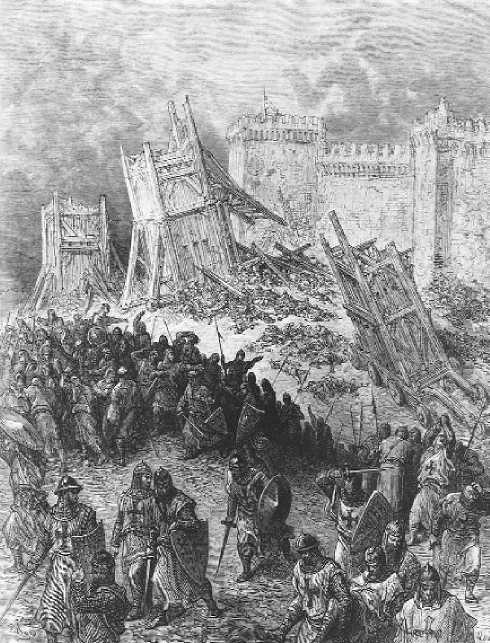The siege of Jerusalem took place during the First Crusade (1096-1099) and culminated in the capture of the Holy City

Second Assault of Jerusalem: The Crusaders Repulsed, by Gustave Dore, 1877. (Bettmann/Corbis)
On 15 July 1099. The liberation of the Holy Sepulchre from the hands of the Islamic enemy was the fundamental inspiration for the crusade. When the crusaders began the siege on 7 June, it was not merely a military objective but the emotional mainspring of the whole expedition, although the army faced substantial problems in undertaking it.
Perhaps 60,000 crusaders had gathered at Nicaea (mod. Iznik, Turkey) in June 1097, but a member of the army estimated that when they got to Jerusalem there remained only 1,200-1,300 knights and 12,000 crusaders on foot. They had suffered heavy losses, and many crusaders had stayed behind with Bohemund of Taranto at Antioch (mod. Antakya, Turkey) and Baldwin of Boulogne at Edessa (fianliurfa, Turkey). This small army was very isolated; its nearest secure base was Laodikeia in Syria (mod. Al-Ladhiqlyah, Syria), over 480 kilometers (300 mi.) to the north. Jaffa (mod. Tel Aviv-Yafo, Israel), the port for
Jerusalem, had been largely demolished, so that the sea power that had hitherto been so useful could now only be exercised precariously, for there was a powerful Fatimid fleet based at Ascalon (mod. Tel Ashqelon, Israel), while Jerusalem itself was held by a Fatimid garrison. The Fatimids of Egypt had been content to support the crusaders against the Saljuq Turks, from whom they had seized the city of Jerusalem in July 1098, but the crusaders broke this arrangement when they marched south to the Holy City. Now they knew that a mighty Fatimid force would gather at Ascalon. The attack on Jerusalem was a race against time: this was why the crusaders first assaulted the city on 13 June, although they had only one siege ladder.
The Fatimid garrison had expelled the native Christian inhabitants and made the springs outside the walls unusable. There was little wood in the vicinity, and raiders from Ascalon harassed the army. Jerusalem, though a mighty city, was vulnerable on the north wall, which was somewhat overlooked by rising ground. The east wall crowned a steep slope down to the Valley of Jehosaphat. The land did not fall away quite so steeply on the west, but here the wall was reinforced by a citadel (the Tower of David) and an outer wall and ditch that extended around to reinforce the north wall. To the south there was a small, level plateau outside Zion Gate, and here Raymond of Saint-Gilles, count of Toulouse, prepared his attack, while the rest of the army concentrated to the north. The crucial event was the arrival of a crusader fleet at Jaffa on 17 June. A crusader force defeated Egyptian forces, opening the way to the coast on 18 June, and escorted back food, timber, and sailors, who provided skilled labor for the manufacture of siege equipment, for their fleet was destroyed in the port by the Egyptians. Thus reinforced, the army began to erect two siege towers. The North French and Lotharingians built one, with a ram to breach the outer wall, at the northwest corner of the city, while the Provencals constructed theirs outside Zion Gate.
On the night of 9-10 July, the northern tower and ram were moved from the west to the east end of the north wall, surprising the defenders. A two-pronged attack was launched on 13 July. On 15 July the North French and Lotharingians broke into the city, causing the garrison of the citadel to surrender to the Provencals in the south. The crusaders massacred most of the city’s Muslim and Jewish inhabitants, but this was the fate of any medieval city that refused to surrender. The capture of Jerusalem was remarkable for the courage and skill of the attackers and for the fact that it was achieved before the Fatimids could gather their relief force at Ascalon.
-John France
Bibliography
Elm, Kaspar, “Die Eroberung Jerusalems im Jahre 1099: Ihre Darstellung, Beurteilung und Deutung in den Quellen des Ersten Kreuzzugs,” in Jerusalem im Hoch - und Spdtmittelalter: Vorstellungen und Vergegenwdrtigungen, Konflikte und Konfliktregelung, ed. Dieter Bauer, Klaus Herbers, and Nikolas Jaspert (Frankfurt am Main:
Campus, 2001), pp. 31-54.
France, John, Victory in the East: A Military History of the First Crusade (Cambridge: Cambridge University Press, 1994).
Kedar, Benjamin Z., “The Jerusalem Massacre of July 1099 in the Western Historiography of the Crusades,” Crusades 3 (2004), 15-76.
Prawer, Joshua, “The Jerusalem the Crusaders Captured: Contribution to the Medieval Topography of the City,” in Crusade and Settlement, ed. Peter W. Edbury (Cardiff: University College Cardiff Press), pp. 1-16.




 World History
World History









